 Palo Alto Stanford Heritage
Palo Alto Stanford Heritage 2010 Holiday House Tour: Palo Alto's First National Register District
Professorville — Our First National Register District was the site of this year's Holiday House Tour.
Homes on tour:
When Stanford University opened in the Pall of 1891, housing opportunities for both students and staff were limited. Some found housing in the town of Mayfleld, especially in the new subdivision of College Terrace which was very convenient to the new college. Others found housing on campus, either in the new dorm or in housing that had been used previously by the workers who built the new campus buildings. There were even a few newly built housing units for the faculty on an unimproved road with few services. But for many of the new faculty, housing was found in the new town of Palo Alto. One of the advantages of Palo Alto over campus housing was that the owner could build the house of his dreams on his own property. Stanford housing was (and continues to be) on leased land.
As the new town of Palo Alto grew, many new homes were built between University Avenue and San Francisquito Creek, and these modest sized houses were mainly occupied by the town's trade men and many blue collar workers. Homes south of University Avenue tended to be built on larger parcels and were owned by more prosperous owners, including many of the new faculty members at Stanford University. One of the reasons for the faculty preference for the blocks south of University Avenue was that access to the campus was more direct for walkers and bicycle riders via Embarcadero Road. Since the neighborhood was developed before the popularity of the automobile and public transportation (the street car opened in 1906), many of the residents depended upon the bicycle for transportation.
Although the neighborhood had many families without Stanford connection, including town merchants and early commuters to San Francisco, the large number of Stanford faculty in the neighborhood led to the name "Professorville". Recognizing its wealth of beautiful homes, built in the many styles favored in the last years of the nineteenth century and the first two decades of the twentieth century, the neighborhood was listed on the National Register of Historic Places as a historic district. Over the years, many of the homes that define the neighborhood have been threatened with demolition or alteration, resulting in the future possibility that this historic designation might be removed.
This Addison home was built around 1900 for Mrs. Kate Schulze, a brilliant pianist who moved to Palo Alto after she was widowed. She also built the house next door at 319 Addison. Her widowed sister, Edith Fallenius moved to Palo Alto with her daughter and supported her family by offering music lessons. The owner has a photo with the musical family on the porch with their "shingle" hung outside. The front gardens of the two houses were a continuous sweep of lawn for many years. From 1918–1929 Horatio W. Stebbins, a professor of mechanical engineering owned the house. He was the son of a well known Stanford trustee and Unitarian minister. The present owners bought the house in 2004 and remodeled it. The remodel garnered a Residential Preservation Award from PAST in 2010 for the work's sensitivity to the historic character of the house. The owners' goal was to preserve the old house while making it livable for a modern family and future generations.
The stylistic origins of the house are Colonial Revival and Craftsman. Notice the interior Arts and Crafts details. There are varying window mullions and Doric column porch supports. The second story balcony emerging from the entry canopy is unusual.
Many of the original materials used to build this home remain: the fir floors, redwood paneling, leaded glass windows and the doors. In the living room the fireplace was rebuilt with the original blocks. The ceiling light in the dining room and the light fixture on the newel post on the stairs are original to the house as is the tub in the hallway bathroom upstairs. Over the years some of the rooms have been reconfigured during remodels. Four bedrooms became three making space for an additional bathroom.
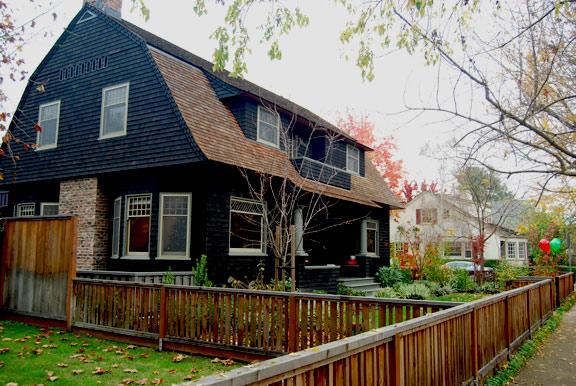
Built in 1893 for Professor and Mrs. Frank Angell in the Colonial Revival Style with some Shingle Style detailing, such as the oval window, and asymmetrical placement of the entry. The house features a dominant double gambrel roof. It has been said that this house was the first in Palo Alto to be designed by an architect (Thomas Bender); contractors were Field and Ledvard.
Frank Angell was chosen by Stanford President David Starr Jordan in 1892 to head the original Psychology Department. 'Doc' Angell became Stanford's first track coach and Chairman of the Committee on Athletics. In 1933, President Wilbur dedicated Angell Field in his honor. Louise Angell was an active supporter of educational and cultural activities. She financed the establishment of Castilleja Hall at 1129 Bryant Street in 1901.
The original house had sitting rooms in the back and front of the house; the large living room was a 1906 addition by Mrs. E. B. Towne, who bought the house from the Angells when they moved to 1200 Bryant Street in 1905. The house was occupied by tenants from 1958 to 1968at one time housing 13 male graduate students.
The house has a tradition of counter–culture. In 1964, Shunryu Suzuki, the Japanese Buddhist priest who brought Zen to the west (founder of the Zen Center in San Francisco), held the first Zen "zazen" practice on the Peninsula in the living room of this house. These practices lasted about a year before they were moved to Los Altos. The house was a little later a renegade "philosophy compound" in which a Stanford Professor of Philosophy broke away from the University and began to teach a group of "graduate students" (see framed newspaper article on wall).
(This house was also part of the 1988 and 1993 tours. Find the links on the Holiday House Tour page.)
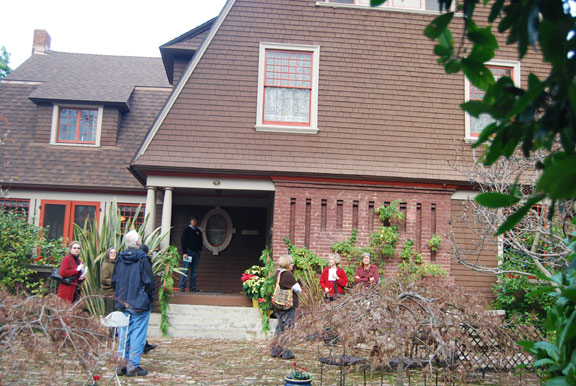
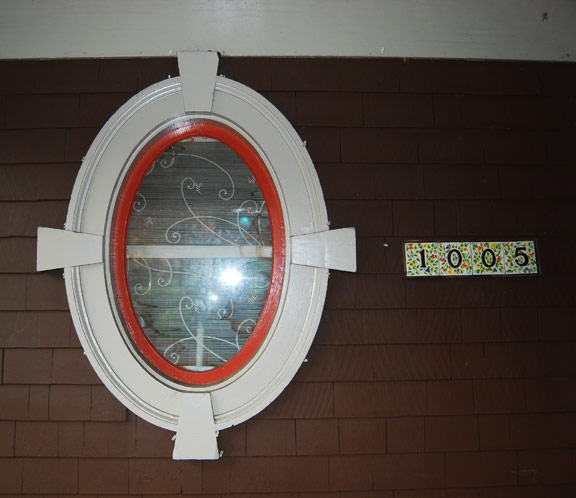
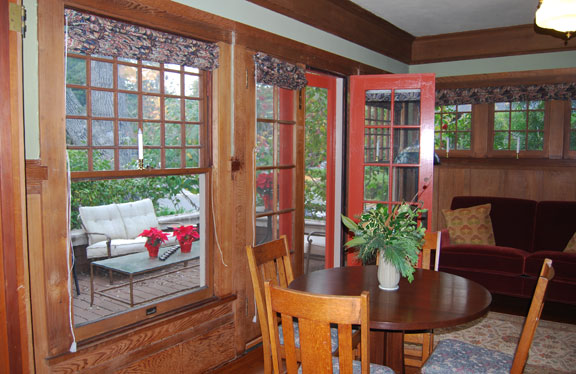
Dr. John Snyder, a zoologist on the Stanford faculty from 1897 to 1932 built this Craftsman home in 1909. Of note are the large dormers projecting from the roof: also note the unusual detailing in the corbelled eave bracketing, placed perpendicular to the roof planes rather than vertical. There was a remodel in the 50s in which many original features, such as the fireplace mantlepiece, were removed. The upstairs of the house was rearranged at that time. The present owners, one of who is a Stanford professor of computer science, bought the house in 2006. Their renovation carefully preserved the home's Craftsman details, including the shingle siding, historic windows, and the corbelled eave brackets, while integrating a second floor addition at the back of the structure.
The original flooring had to be replaced in this home due to multiple sandings. The new flooring is reclaimed Australian hardwood called Jarra that came from a wool factory in Perth. It had been shipped to the United States but not used on the job it was intended for. Its origin resonates with the owners as the husband is Australian. Most of the cabinetry in the house is quarter–sawn gray elm. The fireplace in the living room was taken down and rebuilt with a similar silhouette to the original one, but with a deeper firebox. Note the huge single pocket door in the room. The cabinetry is from the 50's. The front deck had a window and French door opening onto it. The door probably replaced an original window. The current owners removed the door and replaced it with a window to match the others.
Built in 1889 and originally known as the Hutchinson House this Kingsley home is the oldest on the tour. It was constructed for Joseph and Kathryn Kellogg Hutchinson who owned the entire block on which the house stands. Both prominent citizens, Mr. Hutchinson worked as a lawyer, and Mrs. Hutchinson was a charter member of the Palo Alto Women's Club and the Presbyterian Church. In addition to the original house there were two out-buildings (a kitchen which no longer exists and a carriage house) and a tennis court. The house that fronts Kingsley was built in the 1970's. The Hutchinson House is a composite of styles. The Gambrel roof is Dutch Colonial, the semi–circular portico (a later addition) and front door are colonial Revival. The corner tower (the turret of which was lost in the 1906 earthquake) is Queen Anne.
In 1935 the house was purchased by Michael and Sarah Stein. Mr. Stein, an art critic, was the brother of Gertrude Stein who lectured at Stanford University in 1935. She visited her brother on several occasions. The painter Marc Chagall visited the house and was said to have painted a work on the inside of a closet!
The home was owned by Albert and Agnes Robinson from 1954 and 1970. Mrs. Robinson who still resides in Palo Alto was a member of the Palo Alto School Board and of the State Community College and Board of Trustees.
The present owners are a psychologist and a Professor of Genetics at Stanford. They bought the house in 1983. In 1984 the house was the Decorator Show House. The decoration of several rooms dates from this event. The present owners collect ethnic art and artifacts.
As you tour the house you will see many original features. Of particular note are the redwood ceilings and the original library fireplace surrounded with Batchelder tile. You will see original moldings, hardware (brass escutcheons and glass knobs) and doors. The photo in the entry was taken by the owners' son and won first place in a Microsoft contest of 5000 entries.
The 501 Kingsley house was built in 1897 for Professor Ewald Fleugel, a noted philologist and Chaucer scholar who came to work at Stanford in 1892 from the University of Leipzig in Germany. The house originally fronted on Cowper and had a circular driveway surrounding a huge old oak. There was a verandah which wrapped around the house on the Cowper and Kingsley sides. The ground floor bedroom, once a study was added in 1902. The present dining room was the original entry hall. When central heating was installed in 1916, the entry was reoriented to its present location, as was the stair. The entry hall became the present dining room, and the dining room became the present study.
The present owner and her husband purchased the house in 1967 at which time the yard was a sea of asphalt. They then left to live and work in Japan at which time they rented out the home until 1973. Upon their return from abroad the owners found the verandah in danger of falling down and removed part of it. They built an enclosed loggia in the footprint of the verandah in the a modern style with a Japanese influence.
There are many original features in this home. Note the high ceilings including the beautiful tongue–in–groove ceiling in the study, the moldings and doors, the waxed floors and the living room fireplace. The owners kept the kitchen, which dates from the 40's, as they found it. The brick vault in the bedroom was part of the 1897 construction and housed the precious Chaucer manuscripts of Professor Fleugel. One set of closet doors in the bedroom was rescued from the demolition of an intricately crafted bungalow next door. The other set are sliding screens from the Taisho period (1912 to 1925). As you leave, have a look at the beautifully detailed metal door on the garage.
Constructed in 1905 this Ramona house was originally occupied by Mrs. E. Melcer and her daughter. Mr. and Mrs. Franklin P. Steinmetz, who operated the University Pharmacy for 25 years, owned the house from 1911 to 1952. The present owners, a retired firefighter and educator, bought the house in 1974 and raised their three children here. It was a run-down student rental house at the time.
As you tour the house you will see a sleeping porch which was an early addition and so popular that the next door neighbors built one too. The cupboards in the master bedroom came from St. Patrick's seminary. In the living room there is an original bench at the stair. The fireplace, hearth and redwood mantle are also original. Note the huge sliding door to the dining room, the original sideboard with its art–nouveau style glass doors, and paintings by the present owner.
The kitchen which the present owners built in 1978 was featured in Sunset magazine and a Sunset how–to book. Note the porcelain knobs made from old-fashioned knob-and-tube wiring. The breakfast area was formerly a pantry.
Outside there is a small building original to the house that serves as the husband's painting studio.
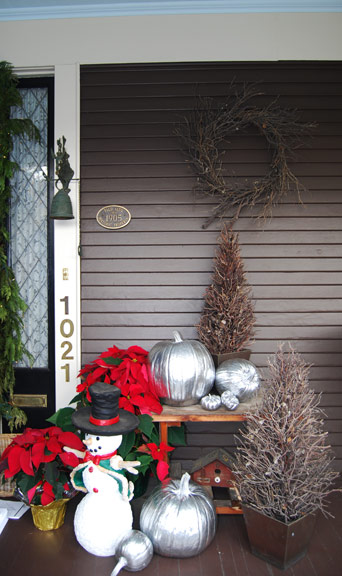
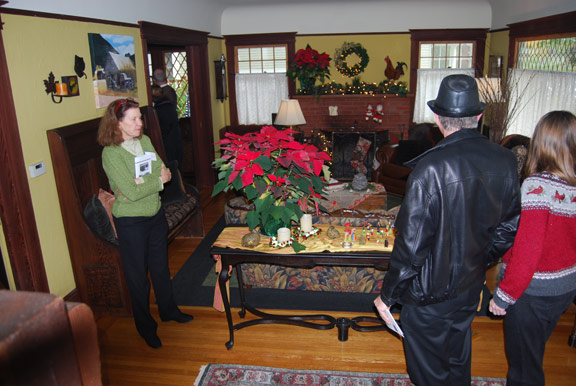
| |
E-mail us at either webmaster@pastheritage.org or president@pastheritage.org.
![]() Palo Alto Stanford Heritage—Dedicated to the preservation of Palo Alto's historic buildings.
Palo Alto Stanford Heritage—Dedicated to the preservation of Palo Alto's historic buildings.
Copyright © 2015 Palo Alto Stanford Heritage. All rights reserved.